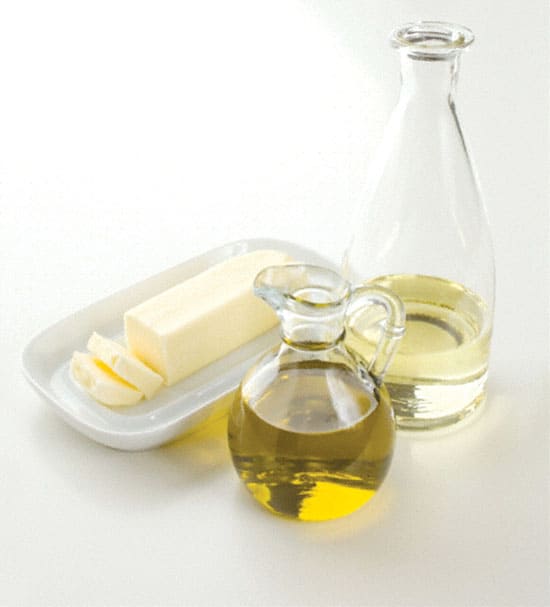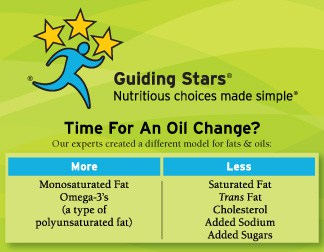Which do you think is better for you, butter or margarine?
Ever since studies came out demonstrating that trans fat is more harmful than saturated fat in terms of heart health, there has been a movement to reinstate butter over margarine as the healthier solid fat. Personally, I think it’s being used as an excuse to eat butter. I mean who doesn’t like butter? When my oldest daughter was preschool age and we went out to a restaurant, she would take a pat of butter and just eat it plain while we were waiting for our food to arrive. I can still see that satisfied look on her face.
Butter is made by mechanically processing (churning) cream or milk turning it into a solid (or saturated fat) at room temperature. Margarine is made by chemically processing oil turning it into a solid fat. This chemical process is known as hydrogenation and the partially hydrogenated oils found in shortening and hard margarines contain the types of trans fats that lower the “good” fats in our bloodstream, high density lipoproteins or HDL.
In terms of heart health, anything that lowers HDL is a no-no. We want to raise HDL levels in our bloodstream – since HDL carry cholesterol to be eliminated by the liver, thus lowering the risk of atherosclerosis or heart disease. Both dietary fats, saturated and trans, raise the “bad” fats in our bloodstream known as low density lipoprotein or LDL. It is obvious that we want to limit saturated and trans fats in our diet, so when we do use a solid fat, which is healthier, margarine or butter?
My opinion is that tub, lower calorie or light margarines are healthier for you than butter, for two reasons:
- The oils used to make margarine are a source of essential fatty acids. The essential fatty acids are linoleic (omega-6) and linolenic (omega-3). Remember that essential means that your body cannot manufacture it so you need to get this nutrient from the foods that you eat.
- You can get lower calorie or light margarines which will provide fewer calories per serving than butter, always. And, many tub margarines are available with no trans fat.
The best fats for you, by far, come in liquid form or oils. Lovely, silky oils that are high in monounsaturated fats such as olive oil and canola oil, and other less well known oils such as flaxseed oil which is a great source, maybe the best source, of the essential fatty acids mentioned above. I used to say that I needed a solid fat such as margarine because I could not spread oil on my toast in the morning. This is no longer true and it has become mainstream to have a small plate of olive oil on tables at restaurants to dip your bread into instead of having that pat of butter there that my small daughter used to gobble up.
Keep in mind that fats are a concentrated source of calories. As a macronutrient fats have more than twice the calories of carbohydrates or protein so while they are needed in our diets, we should be mindful of how much we are eating. You may bemoan the fact that fat is a concentrated source of energy, but if the fat on our bodies wasn’t concentrated, it would take up twice as much space and no one wants that! You might ask, with all the controversy surrounding fats, why eat them at all?
Besides providing essential fatty acids, fats are a major source of calories or energy for the body and help to absorb the fat-soluble vitamins A, D, E, and K. Fat is important for proper growth and development, it provides for the layer of fat under your skin which is insulation for your body, it protects your organs and nervous system, contributes to the production of hormones and is essential for good health. For those of you feeding children, fats are an important source of calories and nutrients for infants and toddlers up to the age of two. And, fat is yummy! It carries flavors, provides taste, and a creamy or rich mouth feel. A great way to add flavor when cooking is to sauté herbs and spices in a small amount of oil to carry those flavors throughout the dish. Another benefit to fat is that is slows digestion allowing us to feel satisfied and full.
Besides foods that contain only fat, there are a variety of foods that are sources of fat. There is fat in meats, in the white marbling and in the muscle tissue, in bacon, the skin on poultry, fatty fish, any milk or dairy food that is not skim or fat free has fat including ice cream, nuts and seeds, and foods fried or baked with fat such as fast foods, baked goods, crackers, pies, cookies, chocolate, etc. Many of these foods have saturated or trans fats and because of that may not earn stars.
Foods that are fats or a source of fats that have Guiding Stars include those high in monounsaturated fats and omega-3 fatty acids such as olive, canola and flaxseed oils, tub margarines, nuts such as walnuts and Brazil nuts, seeds such as flax, pumpkin and sesame, and fatty fish including salmon, mackerel, sardines and tuna. Look for the stars on these foods and enjoy them in your diet.
Do you agree with me? Share your opinion in the comments below.
For more on Heart Health, download Take it to Heart℠ – our guide to shopping and eating for a healthy heart.
About our Nutrition Expert
Lori Kaley MS, RD, LD, MSB is a member of the Guiding Stars Scientific Advisory Panel. Lori has 30 years of combined experience working in healthcare and public health creating policies and environments to help families and children have access to healthy foods and beverages. She is currently Policy Associate at the University of Southern Maine’s Muskie School of Public Service.
Lori’s greatest achievement and joy has been in raising her three daughters to be healthy and productive young adults, each with their own particular love of food, cooking and being physically active. Lori’s passion for nutritional community outreach has been a cornerstone of the Guiding Stars Scientific Advisory Panel. Lori regularly contributes to the Guiding Stars blog.

